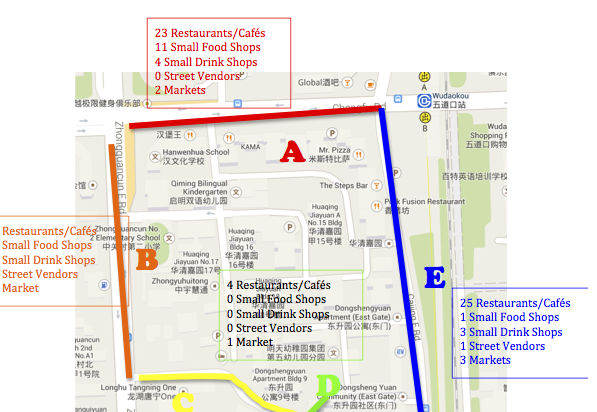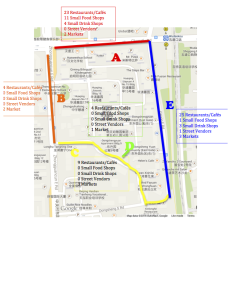Project update by Adriana Baird, Moon, Han Lin (Nancy), Alec Hogan, Zoey Zhou Yang
After a guest lecture from Professor Xie of the NRDC on sustainable urban development, our group took a moment to organize and restructure the plan for our Food Systems project. We discussed and defined the overall objectives of the group project: to conduct the initial research on the relationship between food preferences and urban development that could be used to delve further into to the food systems subject in the future. From there, we decided to focus on three topics within food systems: Quality, Waste, and Culture.
Some examples of questions we hope to address in these topics are:
Quality:
- Where does food come from?
- Is food quality a factor in the decision to buy food from a certain vendor?
- How does food quality vary by the type of food vendor?
- How has food quality changed in Beijing over the years?
Waste:
- What happens to leftover food at the end of the day?
- Do food vendors separate their trash?
- Who picks up the recycling/trash from food vendors?
- Are there trashcans outside restaurants and other food vendors? Are they used?
- Where does the trash/recycling go?
Culture:
- How have families changed the way they eat over time?
- How has family structure changed over the years? Does this affect families’ food preferences?
- Have Chinese dishes changed over the years? If so, what has caused these changes?
- Has the availability of food affected food culture?
For today’s research, we decided to stay in the area surrounding the Wudaokou subway station. This is an interesting area because of its unique environment – it is near to universities and large technology companies as well as some residential areas. In the future, it may be interesting to compare the results of our research in Wudaokou to other micro-communities or neighborhoods and see how they vary.
(Click to download pdf map of the student’s route: map_food_systems)
Because food quality, waste, and culture are each closely liked to human interaction with food systems, in-person interviews were definitely an important part of our research. We separated the types of food vendors into 5 categories – markets, small food shops, small drink shops, restaurants & cafés, and street vendors.
During our field research period today, Nancy, Moon, and Zoey conducted interviews with food vendors in each category. Some of the responses they received that interested them the most included:
- Some smaller food shops are owned by larger companies that supplied the food half-cooked
- No one knew (or was willing to tell) the exact source of their food
- Younger shops (about 5 years old) did not tend to be owned by larger companies; some were family-owned
- Most shops pay someone to pick up the trash at night (about 100 RMB/month)
- None of the interviewees separate recycling
Meanwhile, Alec and Adriana worked on creating a map of the food systems within Wudaokou area. For today, this included documenting the amount of markets, small food shops, small drink shops, restaurants & cafés, and street vendors on each street. They also spent 6 minutes at each type of food vendor, counting how many customers frequented the location within that time frame. This documenting and mapping will continue throughout the rest of the week – by the end of the project, we hope to have a map of the Wudaokou that can be used as a resource for future research in food systems, a characterization of the Wudaokou community’s food system, or a starting point for an investigation of how to improve a community’s food system.
Today’s research was mainly focused on food quality. Tomorrow (Wednesday) we will focus on food waste, and on Thursday we will focus on food culture. It is hard to select specific interesting bits from the research (partially because we haven’t translated the interviews yet), but we are definitely looking forward to seeing how the data take form as our body of research and observations grows.

